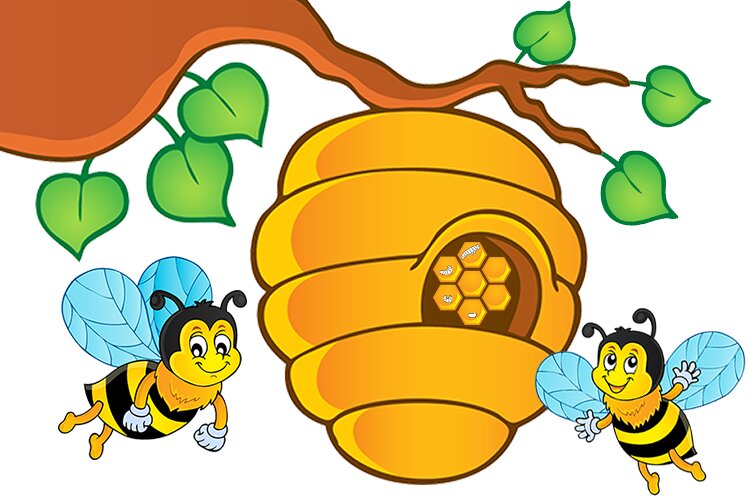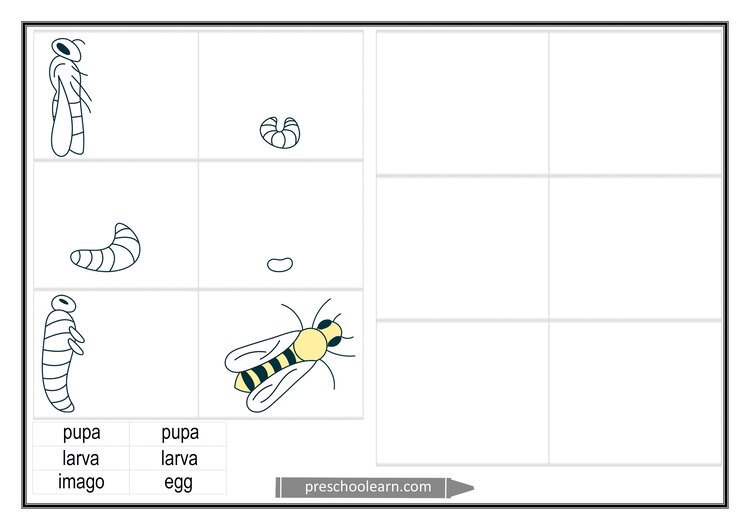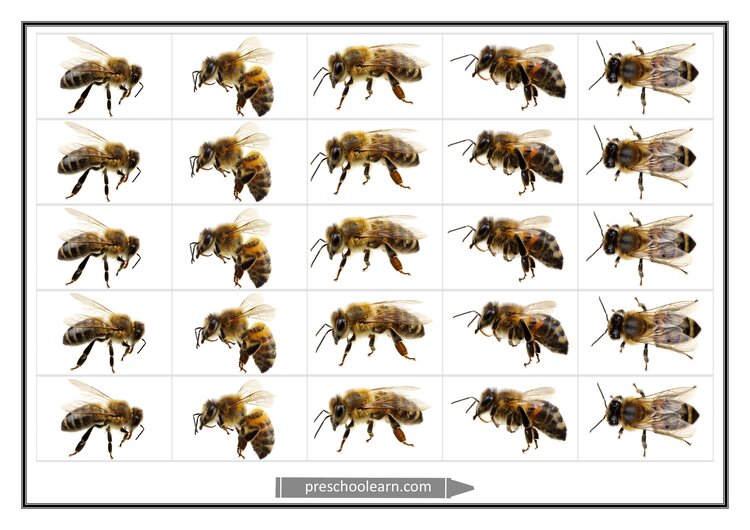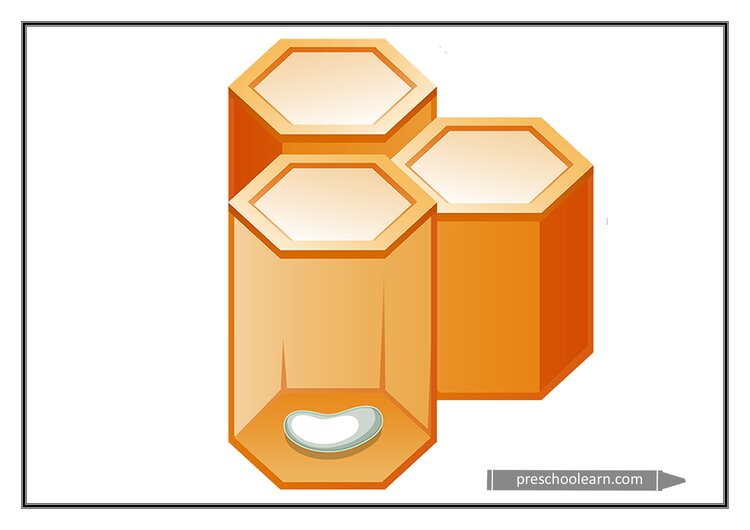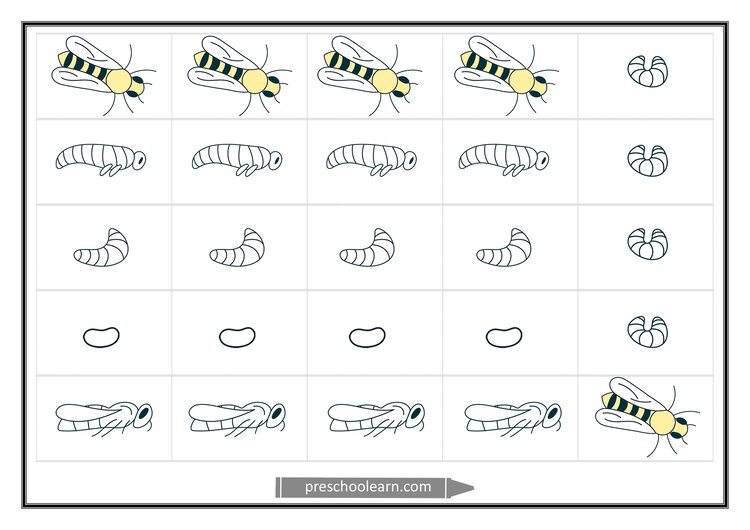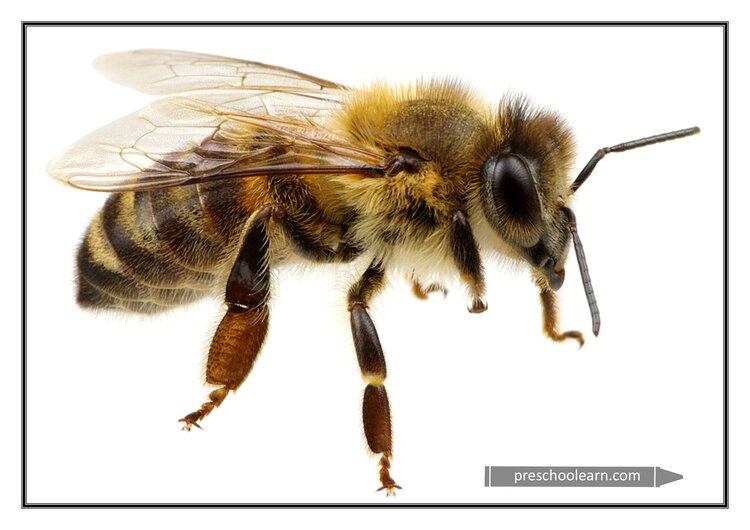Kindergarteners will start the adventure with the bees. They will find out about their hive and division of duties in the bee family. Children will learn about the life cycle of a bee – they will compose a picture story about it and make a worksheet entitled ‘From egg to the imago’. They will also learn about the body part of a bee.
Materials:
emblems of the bees, a song entitled ‘The greetings song’, the sounds of the bees, clapper, an educational film entitled ‘Busy bees’, tambourine, a picture story entitled ‘Growth of bee’, a picture card with the life cycle of a bee, cards with captions, emblems with the life cycle of a bee, a song entitled ‘Fuzzy Buzzy Honeybees’, a worksheet entitled ‘From egg to imago’, scissors, glue sticks, a picture card with the body of a bee, arrows, cards with captions, janissary.
Activity description:
* Teacher, before the lesson, places emblems of the bees in different places in the classroom (keeping it secret from children, for example, during breakfast).
1. ‘Welcome song’ – greeting children with a song – teacher and children stand in a circle. Teacher sings the song and shows the correct movements. Children try to imitate them.
Hello everyone, how are you? (wave to each other)
How are you? How are you?
Hello everyone, how are you?
How are you today?
Hello everyone, clap your hands! (clap your hands)
Clap your hands! Clap your hands!
Hello everyone, clap your hands! (wave to each other and clap your hands)
Clap your hands, today!
Hello everyone, stomp your feet! (stomp your feet)
Stomp your feet! Stomp your feet!
Hello everyone, stomp your feet! (wave to each other and stomp your feet)
Stomp your feet, today!
Hello everyone, touch your nose. (touch your nose)
Touch your nose. Touch your nose.
Hello everyone, touch your nose. (wave to each other and touch your nose)
Touch your nose, today.
2. ‘What’s that buzzing?’ – introduction to the topic by the auditory puzzle – the teacher asks children to lie down on the carpet, close their eyes, listen to the sounds and imagine where they could be. After about 1 minute, teacher turns off the sounds and asks children to open their eyes and sit in a circle. Next, he/she asks them about their imaginations and guesswork. Then, teacher informs them that during the next activity, they will get to know more about the insects they heard of.
3. ‘Buzzed bees’ – movement fun – children run, buzzing and moving their hands like insects, during the playing clapper by a teacher. They look around the classroom, looking for hidden pictures. When the music stops, they pick up the bees that they found. Continue the activity until they collect all emblems. Next, children sit in a circle and place the bees in front of them (they can group and count them). Teacher asks about the insects from the activity before and their living environment. Next, teacher informs them that they will meet the bees – they will look to their beehive.
4. ‘Visit a beehive’ – watching an educational film – teacher invites children on an adventure with the bees. After that, he/she talks with them about the movie.
- What type of animals are bees?
- How many legs and wings do bees have?
- Does every bee have a sting?
- What is the sting for?
- What is the name of the most important bee?
- What work do bees do?
- What does it mean ‘Busy as a bee’?
- How should we behave, when we meet a bee?
5. ‘Bee duties’ – movement fun – children move in the kindergarten room to the rhythm, played on a tambourine by their teacher. When the music stops, teacher says one of the bee’s duties, for example, ‘cleaning/feeding/repair of honeycombs/protection of the hive/collecting pollen’ and children show it by movements. Repeat it 4-5 times.
6. ‘Growth of bee’ – composing a picture story – teacher asks children what happens to the eggs laid by the queen? When they answer, teacher places on the carpet a picture card entitled ‘Growth of bee’ and tells about it:
The queen lays eggs to the wax combs. The larvas hatch from eggs. Workers feed them and after 10 days they are so much larger. The larvas cocoon and become still. The larvas change into a pupa that looks like an adult bee – in the first picture about the 14th day, in the next about the 18th day. When the bee became an imago, she bites out of the division. Imago is an adult insect. Bees undergo a metamorphosis about 21-24 days, the queen – 16 days. The sex of the bees depends on fertilized the egg. Males are made from unfertilized eggs. Females – workers and queens – develop from fertilized eggs. It is determined by the type of food supplied to the larva. Queen’s larvas are fed with royal jelly.
Next, teacher places on the carpet the cards from a picture story and asks children to choose, describe and compose them in the correct order. They can look to ‘The life cycle of bee’. Next, teacher places cards with the names of the stages, children read them and assign to the correct pictures. They repeat names very quietly, then a little louder, and finally very loudly.
7. ‘The life cycle of a bee’ – movement and didactic activity – teacher gives out to children the emblems with the life cycle of a bee. They move in the kindergarten room to a song entitled ‘Fuzzy Buzzy Honeybees’. When the music stops, they have to form groups with the same picture. Next, they call their stage and try to set the groups in the correct order. If they have problems, teacher can help them. After the correct setting and reminder of the names of the stages, children exchange their emblems – they can’t exchange with the child from the same group. Repeat this activity 3-4 times.
8. ‘From egg to imago’ – worksheet – teacher shows a worksheet and explains to children how they have to do the task (cut out the rectangles with the pictures and stick them in the correct order. Cut out the rectangles with the names. Stick them to the correct pictures). Next, teacher asks children to go to the tables and distributes the worksheets. During the work, teacher walks between the desks and helps children if they need it.
9. “The Bees Go Buzzing” – movement activity – children move around the room according to the lyrics. Teacher can pause the song after each verse and let them know how many children should be in the group.
The bees go buzzing one by one. (march individually)
Hoorah! Hoorah!
The bees go buzzing one by one.
Hoorah! Hoorah!
The bees go buzzing one by one.
The little one stops to have some fun. (laugh)
And they all go flying high, in the sky.
To go back, to their hive.
Buzz, buzz, buzz.
The bees go buzzing two by two. (march in pairs)
Hoorah! Hoorah!
The bees go buzzing two by two.
Hoorah! Hoorah!
The bees go buzzing two by two.
The little one stops to sing a tune. (imitate singing)
And they all go flying high, in the sky.
To go back, to their hive.
Buzz, buzz, buzz.
The bees go buzzing three by three. (march in threes)
Hoorah! Hoorah!
The bees go buzzing three by three.
Hoorah! Hoorah!
The bees go buzzing three by three.
The little one stops to scratch her knee. (scratch the knee)
And they all go flying high, in the sky.
To go back, to their hive.
Buzz, buzz, buzz.
The bees go buzzing four by four. (march in fours)
Hoorah! Hoorah!
The bees go buzzing four by four.
Hoorah! Hoorah!
The bees go buzzing four by four.
The little one stops to sing once more. (imitate singing)
And they all go flying high, in the sky.
To go back, to their hive.
Buzz, buzz, buzz.
The bees go buzzing five by five. (march in fives)
Hoorah! Hoorah!
The bees go buzzing five by five.
Hoorah! Hoorah!
The bees go buzzing five by five.
The little one stops to exercise. (do jumping jacks)
And they all go flying high, in the sky.
To go back, to their hive.
Buzz, buzz, buzz.
The bees go buzzing six by six. (march in sixes)
Hoorah! Hoorah!
The bees go buzzing six by six.
Hoorah! Hoorah!
The bees go buzzing six by six.
The little one stops to make a wish. (imitate to make a wish)
And they all go flying high, in the sky.
To go back, to their hive.
Buzz, buzz, buzz.
The bees go buzzing seven by seven. (march in sevens)
Hoorah! Hoorah!
The bees go buzzing seven by seven.
Hoorah! Hoorah!
The bees go buzzing seven by seven.
The little one stops to ask directions. (shake your heads to the right and left)
And they all go flying high, in the sky.
To go back, to their hive.
Buzz, buzz, buzz.
The bees go buzzing eight by eight. (march in eights)
Hoorah! Hoorah!
The bees go buzzing eight by eight.
Hoorah! Hoorah!
The bees go buzzing eight by eight.
The little one stops to pollinate. (shake your legs)
And they all go flying high, in the sky.
To go back, to their hive.
Buzz, buzz, buzz.
The bees go buzzing nine by nine. (march in nines)
Hoorah! Hoorah!
The bees go buzzing nine by nine.
Hoorah! Hoorah!
The bees go buzzing nine by nine.
The little one stops to starts to fall behind. (turn around)
And they all go flying high, in the sky
To go back, to their hive
Buzz, buzz, buzz.
The bees go buzzing ten by ten. (march in tens)
Hoorah! Hoorah!
The bees go buzzing ten by ten.
Hoorah! Hoorah!
The bees go buzzing ten by ten.
The little one stops to shout,
“THE END!” (sit down)
10. ‘The body of bee’ – didactic activity – teacher places on the carpet a picture card with the body of a bee and talks with children about it.
The body of a bee consists of three main parts: head, thorax, and abdomen.
On the head, there are eyes, antenna, and mouthpiece to collect nectar from flowers. On the thorax, they have wings and three pairs of legs. On the legs in the back, there are baskets to carry pollen. The abdomen has a sting for defense.
Next, teacher places the cards with the names of the body parts of a bee and they together try to read them. Teacher asks children to assign cards to the arrows with the right body parts. Finally, teacher shows the body parts of a bee and they together name them.
11. ‘Show me where …’ – movement and didactic activity – children move in the kindergarten room to the rhythm played by a teacher on a janissary. During a break, teacher says the sentence: ‘Show me, where you have the head/eyes/nose/legs/sting/abdomen’. Children have to point at themselves the right body part. If teacher says the body part of a bee, not a man, they have to buzz like bees and turn around. Repeat it 5-6 times.
Attachments:
Emblems for the ‘Buzzed bees’ activity
Picture story, pictures card and captions for the ‘Growth of bee’ activity
Emblems for the ‘The life cycle of bee’ activity
Worksheet entitled ‘From egg to imago’
Picture card and captions for the ‘The body of bee’ activity
Pages used:
- https://www.youtube.com/watch?v=OsFV58Jps2k – a song entitled ‘Welcome song’
- https://www.youtube.com/watch?v=-d3ABrrlkIs – the sounds of bees for the ‘What’s that buzzing?’ activity
- https://www.youtube.com/watch?v=ta154f5Rp5Y – an educational film for the ‘Busy bees’ activity
- https://www.youtube.com/watch?v=XV0y9GxKwS0&ab – a song entitled ‘Fuzzy Buzzy Honeybees’ for the ‘The life cycle of a bee’? activity
